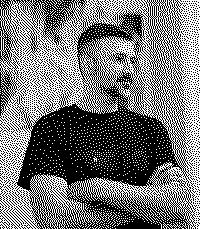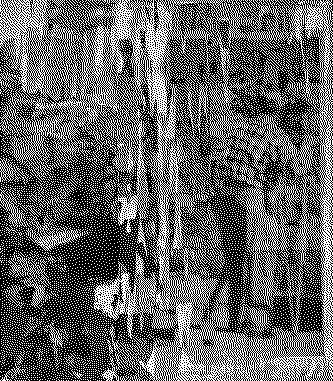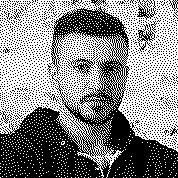Artists/Avery Singer
Fast Facts
Digital Techniques in Traditional Painting:
Singer is celebrated for her use of digital tools in the creation of her paintings. She often employs 3D modeling software to design her compositions, which are then meticulously transferred onto canvas using a projector and airbrush.
Monochromatic Palette
Much of Singer's work is characterized by a monochromatic palette, often using shades of black, white, and gray. This choice gives her work a stark, graphic quality that highlights the interplay of light and shadow.
Exploration of Artistic Process and Art History
Her work frequently explores the process of art-making and references art history. Singer often includes elements or scenes that reflect on the nature of artistic creation and the role of the artist.
Abstract and Figurative Elements
Singer's paintings blend abstract and figurative elements. Her subjects, often figures or objects, are rendered in a geometric, almost computer-generated style, set against abstract backdrops.
Critique of Contemporary Culture
Her art often contains a critique of contemporary culture and the art world. Through her unique style, she comments on the impact of technology, the nature of representation, and the commodification of art.
Biography



Avery Singer, born in 1987, is an American artist who has distinguished herself in the contemporary art world through her innovative digitally assisted paintings. She harnesses 3D modeling software and computer-controlled airbrushing to create her pieces, a technique that marries the realms of digital design and traditional painting in a unique and thought-provoking way (Wikipedia).
Singer was raised in an artistic environment, the child of artists Janet Kusmierski and Greg Singer. Her academic path led her to the Cooper Union, where she graduated in 2010. Following her education, Singer has worked out of studios in the Bronx and Bushwick, Brooklyn, indicating her strong connection to New York's vibrant art scene (Wikipedia).
Her work is characterized by the use of architectural, automation, and other modeling software to create detailed backdrops, which are then brought to life through layers of airbrushed images. These images often draw from internet searches, spanning genres and trends inherited from art history, and showcase a spectrum from black, white, and grays to more colorful palettes in her later works. Singer’s art is deeply influenced by historical movements such as Constructivism, Futurism, and Cubism, as well as by contemporary artists like Charline von Heyl (Wikipedia).
Singer’s talent and innovative approach have not gone unnoticed. Her first European museum solo exhibition was presented by curator Beatrix Ruf at the Stedelijk Museum in Amsterdam in 2016, showcasing her works from 2012 onwards. This exhibition marked a significant moment in her career, cementing her status in the international art community (Wikipedia). Moreover, her artworks are part of prestigious public collections including the Museum Ludwig, Stedelijk Museum, The Whitney Museum, Hammer Museum, and the Metropolitan Museum of Art. Her contribution to the art world was recognized when she won the annual Prix Jean-François Prat in 2017 (Wikipedia).
One of her early solo exhibitions at Kraupa-Tuskany Zeidler in Berlin in 2013, titled ‘The Artists,’ explored stereotypes surrounding the lives and socialization of artists through a satirical lens. This exhibition featured works that delved into the myths of artistic bravado, inebriation, and narcissism, demonstrating Singer’s keen ability to critique the art world from within. Her subjects, rendered in constructivist-like forms, express exaggerated poses and emotions, further bridging the gap between digital rendering and physical expression (Hauser & Wirth).
Beyond her early work, Singer has continued to push the boundaries of painting, incorporating new technologies to explore past art historical references and the current state of image-making. Notably, her self-portrait exhibited at the 2019 Venice Biennale showcased innovative techniques involving liquid rubber, spray bottles, and watered-down white paint to mimic the effect of foggy glass, challenging traditional modes of representation and perception in painting (Hauser & Wirth).
Avery Singer's career is a testament to the evolving nature of art in the digital age, seamlessly blending technology with traditional painting techniques to question and expand the boundaries of visual expression (Ocula). Her art serves not only as a reflection of contemporary society’s relationship with technology but also as a profound commentary on the art world’s historical and cultural narratives.
Importance
Avery Singer's work in the contemporary art world stands as a significant blend of technological innovation and artistic exploration.
Innovative Use of Digital Technology in Painting
Singer is at the forefront of integrating digital technology into the traditional art form of painting. Her use of 3D modeling software and computer-controlled airbrushing to create her artworks represents a pioneering approach, blending the precision of digital design with the spontaneity of painting. This innovative method not only challenges the conventional boundaries of painting but also reflects contemporary society's integration with technology (Wikipedia).
Reinterpretation of Art Historical References
Singer's work is notable for its reinterpretation of past art historical movements and references through a contemporary lens. By employing motifs and stylistic elements from movements such as Constructivism, Futurism, and Cubism, Singer creates a dialogue between the past and present, questioning and expanding upon traditional artistic narratives. Her art acts as a bridge, connecting historical artistic practices with current digital and technological advancements (Hauser & Wirth) (Ocula).
Exploration of the Artist's Role and Art World Critique
Through early works such as those in her exhibition 'The Artists', Singer critically explores stereotypes and myths surrounding the life of an artist. By parodying the social and professional expectations of artists, her work delves into the performative aspects of the art world, highlighting the often-unspoken rules and dynamics that govern artistic creation and reception. This introspective approach offers a satirical, yet insightful critique of the art world, inviting viewers to reconsider the artist's role in society (Hauser & Wirth).
Contribution to Feminist and Conceptual Art Discourses
Singer's work contributes significantly to feminist and conceptual art discourses. Through her exploration of gender, identity, and the human condition, her art engages with broader conversations about the role of gender in art and society. Singer's practice, which often interrogates the representation of the female body and challenges traditional gender norms, aligns her with the feminist art movement, contributing to the ongoing dialogue around gender, power, and representation in the art world (Hauser & Wirth).
Recognition and Impact on the Art Market
Singer's recognition within the art world, exemplified by her inclusion in prestigious collections and significant sales at auction, underscores her impact on the contemporary art market. Her ability to command attention in both institutional and commercial contexts speaks to the broad appeal and importance of her work. As a relatively young artist achieving significant milestones, Singer's success also reflects shifting dynamics within the art market, where innovation and technological integration are increasingly valued (Wikipedia) (Ocula).
Technique
Avery Singer's artistic technique is a fusion of traditional painting methods and cutting-edge digital processes, showcasing a distinctive approach within contemporary art.
Utilization of 3D Modeling Software
Singer employs 3D modeling software to conceptualize and design her artworks. This digital approach allows her to create complex and detailed preparatory sketches that serve as the foundation for her paintings. The use of technology as an integral part of her creative process underscores a modern approach to art-making, blending the digital with the tactile (Wikipedia).
Computer-Controlled Airbrushing
A significant aspect of Singer's technique is her use of computer-controlled airbrushing. This method involves transferring her digital designs onto canvas using a machine traditionally used for commercial purposes, such as printing logos on trucks and airplanes. This innovative application of technology enables precise and intricate layers of paint to be applied, producing textures and effects that are difficult to achieve by hand (Wikipedia).
Layered Airbrushing Technique
Singer's paintings are characterized by their layered airbrushed images, which are built up through a meticulous process of applying multiple layers of paint. This technique allows for the creation of depth and complexity within her works, as the layers interact with one another to form the final image. The use of airbrushing contributes to the distinctive visual quality of her paintings, which often blend realism with abstraction (Wikipedia).
Integration of Art Historical and Internet-sourced Imagery
In her compositions, Singer often integrates imagery sourced from art history and the internet. This approach allows her to draw upon a wide range of visual references, combining them in novel ways to create unique scenes and narratives. Her work thus becomes a dialogue between past and present, digital and analog, reflecting on the nature of art and image-making in the contemporary era (Wikipedia).
Experimentation with Color and Form
Initially focusing on a monochromatic palette, Singer has expanded her use of color in more recent works. Her exploration of color and form is informed by her digital design process, allowing for experimentation with hues and shapes in ways that challenge traditional painting conventions. This evolution in her use of color further demonstrates her willingness to push the boundaries of her medium and explore new possibilities within her artistic practice (Wikipedia).


